A love letter to Bawa and to Lanka
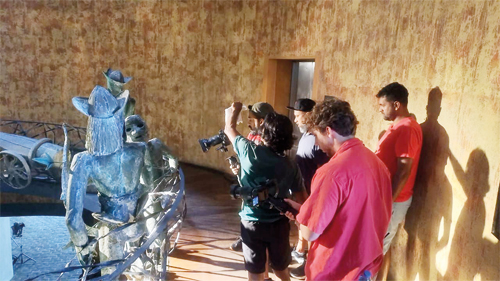
On location: At the Jetwing Lighthouse Hotel in Galle
Afdhel Aziz grew up with Geoffrey Bawa pretty much always on the horizon. At school at S. Thomas’ Prep Kollupitiya there was that classic building with the giant mural of hornbills in a jungle. When as a boy he went on cycle rides at dusk near home in Kotte, he was ever silhouetted against the Parliament. Family holidays away from Colombo often meant staying at hotels and resorts designed by Bawa.
So it is no surprise that this author, visionary founder and keynote speaker, now domiciled in Los Angeles, California, should mull over the greatest Sri Lankan architect – and the million dollar question – how did Bawa create his magic?
Afdhel’s new film titled ‘Bawa: the Genius of the Place’ aims to put the architect on the international mantelpiece, amongst such icons as Philipp Johnson, Oscar Niemayer and Luis Barrigan- a place he richly deserves, says Afdhel.
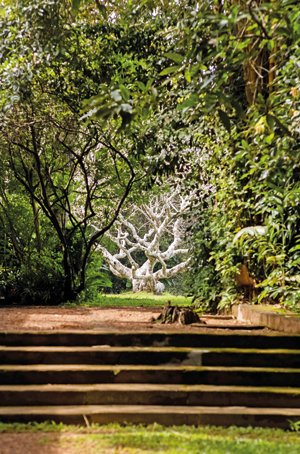
Bawa’s special place: Lunuganga. Pic by Paul Yu
Having worked with TNL Radio and the Sunday Times straight out of school, Afdhel is now founder and Chief Purpose Officer of Conspiracy of Love, a global purpose consultancy that serves his mission to solve one of the biggest problems facing individuals and companies in the 21st century: how to find purpose and meaning in their work and unlock the enormous power of business to do good in the world.
He mentors Fortune 500 companies — including Adidas, PepsiCo, Sephora, Microsoft and more — to help them grow their businesses by doing more good in the world.
He is also co-founder of Good is the New Cool, a creative company and content incubator focused on creating positive stories that fill the Hope Gap – basically sharing inspiring stories across books, films, and podcasts that show people how to use their talents and resources to create a better world. They also create engaging experiences to help leaders learn how to implement bold creative actions to lead to impactful social change.
Having never bid adieu to his pen, Afdhel’s collection of poetry ‘China Bay Blues’ won the State Literary Award for poetry and was also shortlisted for the Gratiaen Prize in 2003. A novel, Strange Fruit came out in 2014.
“This film is a love letter to Bawa- but also a love letter to Sri Lanka,” says Afdhel in an email interview explaining that he wants to show people “the magic and wonder of our beautiful island, in a way that makes them want to get on a plane, and come visit the country and see the buildings for themselves.”
They soon hope to sell this film to distributors like National Geographic, Discovery Channel, and Netflix and also to terrestrial channels like the BBC in the UK, CBC in Canada and ABC in Australia.
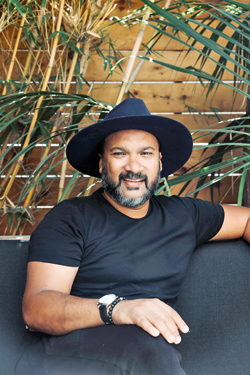
Afdhel Aziz: Capturing Bawa’s vision on film
Afdhel believes only a Sri Lankan team can tell the story of Bawa, so everyone down to graphic designers and music composers are local.
One of Bawa’s favourite dictums was that ‘architecture cannot be explained but must be experienced’.
The film is testimony to it with its breathtaking vistas of five major Bawa buildings: Kandalama’s jungle covered splendour ; the Lighthouse hotel full of the ocean’s salty spray and romance; Lunuganga with Greek statues against the shimmering Bentota River; the Ena de Silva house, with its inner courtyard and Red Cliffs in Mirissa where you feel at the same level with sea and land.
The brief given to the team had but three words: Epic (show the size and scale of Bawa’s imagination and the landscape of Sri Lanka); Cinematic (the experience should be vibrant and enticing, showing the magic and wonder of the buildings and the island) and Immersive (the viewer should feel like they are actually there and moving through the spaces he created).
They had drones soaring like birds to capture vistas never seen before. From that distance, says Afdhel, it was easy to see that landscape and context that inspired the design, one flowing seamlessly into the other.
Initially, however, Afdhel’s was a simpler, more prosaic plan – to talk at length to three people who had shared Bawa’s serendipitous forays into everything from batiks to astronomy – Laki Senanayake, Barbara Sansoni and Ena (Aluvihare) de Silva.That idea had to be scrapped because Covid-19 struck and the three artists also had passed away.
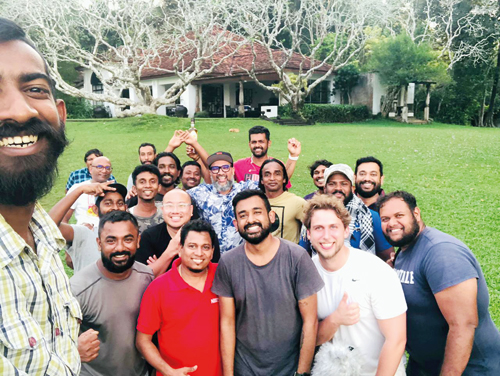
At Lunuganga: Afdhel sharing a moment with the passionate and persevering crew
Instead the project rolled on with a more visual emphasis, and the contributions were by clients and contemporaries like “Pradeep Jayawardene, the owner of Red Cliffs, Hiran Cooray from Jetwing about the Lighthouse, Channa Daswatte and Murad Ismail from MICD Architects… and also Sunela Jayawardene who was able to shine a light on how Mr Bawa drew inspiration from traditional Sri Lankan architectural forms”.
The economic crisis then had its effect and with persistent power cuts shooting had to be abandoned in March last year, Afdhel returning to Sri Lanka only in December.
The shoot was “pretty gruelling”: 12 hour days for 12 days straight in four locations around Sri Lanka.
“‘But thanks to the determination and passion of the crew it was a great experience.” United in the higher goal of making a film that captured the magic and wonder of Sri Lanka and sparked a desire in people to come and visit the buildings, they had four units-“one with a Red camera shooting in 8k, a drone unit for the epic overhead shots, and two other units shooting close-ups and details in 4k. That way we were able to cover a lot of ground in each location.”
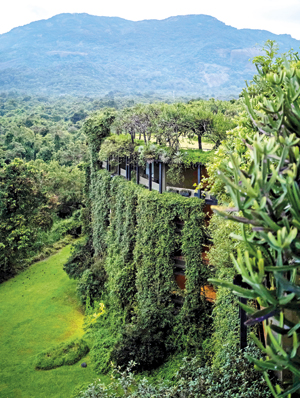 The film is linear and follows Bawa’s life looking at how he started as ‘potterer’- a barrister with a garden to plan, till he became a master architect.
The film is linear and follows Bawa’s life looking at how he started as ‘potterer’- a barrister with a garden to plan, till he became a master architect.
“We look at how he faced different challenges throughout his career – from the constraints of building materials in Sri Lanka in the Sixties, to the opposition to his projects like Kandalama, to his failing health at the end of his life – and how he overcame them through his talent and determination.”
Asked what sort of epiphany visited him as, on that last day of shooting at the Red Cliffs, they packed up for good, Afdhel says he realized that “Mr Bawa was reacting to the overall ‘genius’ of Sri Lanka itself: the incredible natural beauty and spiritual energy of our island home.”
“He was trying to remove the barriers between us and that energy so we could experience it on a daily basis – in his homes, his hotels, his public buildings. He understood the healing power of nature and how reminding us of the magic and wonder around us was good for our spirits and our souls…”
Bawa: the Genius of the Place will premiere in Sri Lanka in July. Learn more about the film on http://
www.thegeniusoftheplace.com/
Searching for an ideal partner? Find your soul mate on Hitad.lk, Sri Lanka's favourite marriage proposals page. With Hitad.lk matrimonial advertisements you have access to thousands of ads from potential suitors who are looking for someone just like you.


